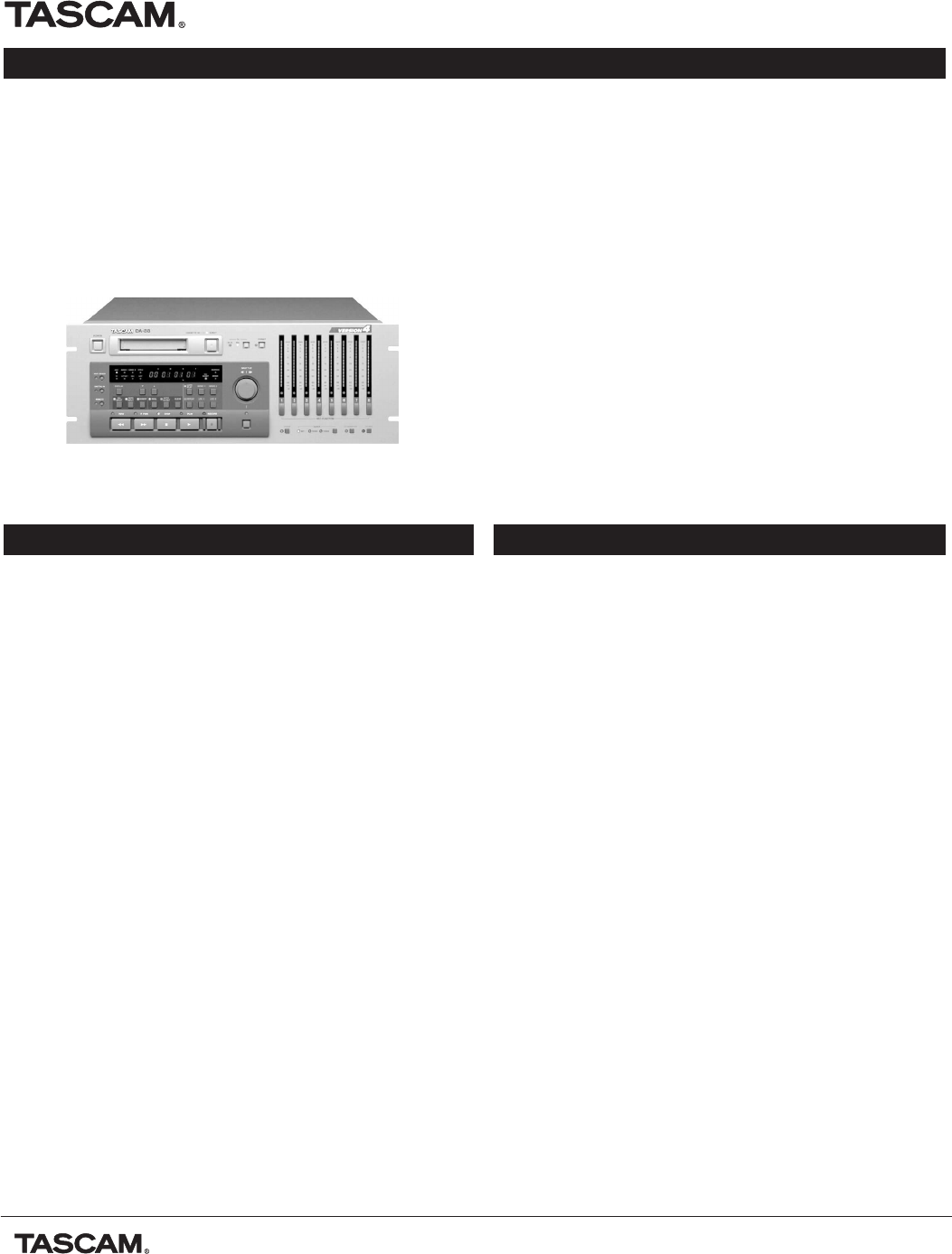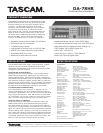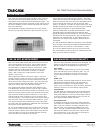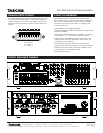
DA-78HR Technical Documentation
7733 Telegraph Road • Montebello, CA 90640 • (323) 726-0303 • http://www.tascam.com
All features and specifications are subject to change without notice. Contact your local TASCAM representative for the latest information.
Page 2 of 3
DA-78HR_TECHDOC.pdf
032500
DTRS HISTORY
Ever since the introduction of the DA-88 in 1992, users of
all levels have been using DTRS machines to create, mix,
and transfer their tracks at home and between studios. The
DTRS standard has become renowned for top quality sound,
top notch reliability, and the fastest transport and machine
lock in the business.
The DA-88 was originally intended for the music market,
but since it was so full featured, it also found its way into
major television and motion picture studios. The DTRS
format has long been the standard format to move audio
from one studio to the next, due to the affordable nature
of the machine and media, as well as the high audio
quality. In addition, a number of studios have been using
DA-88s to expand their track count by having the DA-88
chase analog machines, or other digital formats.
With the introduction of the DA-38 and DA-98 in 1996,
the DTRS machines added some new features like a
digital patchbay, test tone oscillators, and an even faster
transport than the original DA-88. Still, the DA-88 had
made such an indelible mark on the industry that it's
production was continued by popular demand into the
year 2000.
The DA-78HR and DA-98HR are following in the footsteps
of its heritage, continuing the traditions established and
attested to over the years at a new standard - 24 bit.
All in all, the DTRS machines give you the best sound,
the most flexibility, and tried and true reliability that has
been proven for almost a decade.
THE 24 BIT ACHIEVEMENT BACKWARDS COMPATIBILITY
When the 24 bit DTRS format was announced, most users
were curious about how we did it. 24 bit audio requires
50% more data than the original 16 bit format, yet the
DA-78HR didn't cut back on tracks or record time. Many
assumed that the 24 bit format would have been less
reliable since more information is written in a smaller
space. Well, actually the 24 bit format is even more
reliable. Here's why:
When digital information is written to tapes, it isn't like
writing a bunch of ones and zeros on a piece of paper. All
the data passes through an encoder and decoder (codec)
when going to and coming from tape. The coding process
utilizes a lossless algorithm allowing a larger amount of
data to be stored in the same amount of space.
The original DTRS format utilized a codec based on the
8-10 Modulation Principle used by most all DAT recorders.
This format has been around for almost two decades; more
efficient encoding schemes have been developed over time.
High resolution DTRS machines utilizes the 1-7 RLL (Run
Length Limited) codec commonly used in hard drive and
DVD technologies. This format is 66% more space efficient
than the codec used in the original DTRS machines. Since
only 50% more data was needed to store the audio itself,
the other 16% was dedicated to additional data verification
beyond the original DTRS machine.
So, the 24 bit DTRS machines do not reduce the print size.
The write area is actually about the same size. The 24 bit
machine utilizes a better codec which offers more efficient
use of the space, as well as increased reliability through
more accurate data verification processes.
When the high resolution machines were designed, the
ability to work with the original 16 bit machines like
DA-38s, DA-88s, and DA-98s was a high priority.
Sync Chain
High resolution DTRS machines use the same DTRS
Sync line that the previous machines used. So, you
can lock any combination of 16 bit machines with
24 bit machines sample accurately in 2 seconds or
less.
Audio I/O
The new high resolution DTRS machines use the same
DB25 plugs for balanced audio, and TDIF lines for
transfers and integration into digital studios. This
means if you are trading out 16 bit machines for 24 bit
machines, there are no new cabling requirements.
Tape Format
The DA-78HR can read and write 16 bit format tapes,
allowing HR users to seamlessly work with owners of
older DTRS machines. However, 24 bit tapes created
on a high resolution DTRS machine will only work on
other high resolution DTRS machines.
Time Code Track
In addition to the 8 tracks of audio, DTRS machines
can handle two separate time tracks in subcode of the
tape. One of the tracks is the tape's absolute time,
and the other is an independent SMPTE time code
track. The high resolution DTRS machines can read
and write this SMPTE time code track in both 16 bit
and 24 bit format, so you can continue working the
same way you are used to working.
TASCAM's DA-88, the original DTRS format recorder





